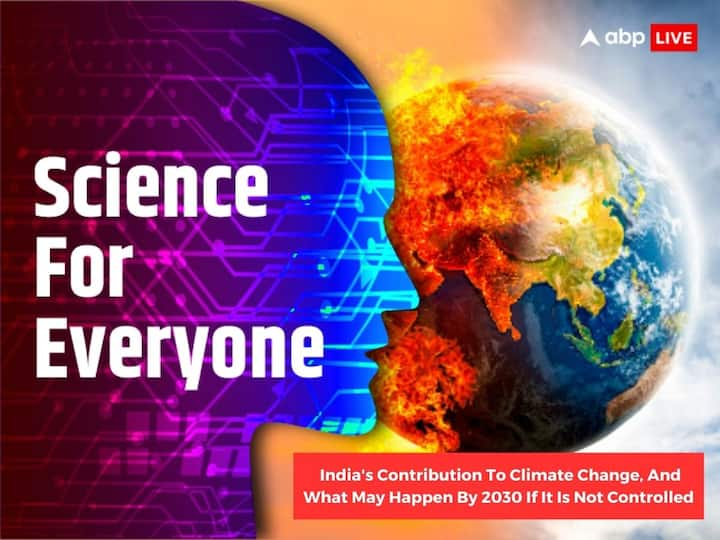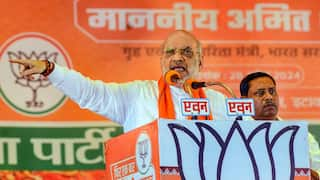
Science For Everyone: India's Contribution To Climate Change, And What May Happen By 2030 If It Is Not Controlled
Science For Everyone: This week, on ABP Live's science column, we discuss how India contributes to climate change, and what may happen by 2030 if appropriate steps are not taken to control it.

Science For Everyone: Welcome back to "Science For Everyone", ABP Live's weekly science column. Last week, we discussed what the period table is, and its significance. This week, we discuss how India contributes to climate change, and what may happen by 2030 if appropriate steps are not taken to control climate change. Climate change is real, and is making its presence felt through extreme weather events, unprecedented heat waves, unseasonal rainfall, and increased incidence of diseases.
In recent years, the urban heat island effect has become more pronounced in different parts of the world, including India. Climate change has a role to play in the unseasonal rainfall received by certain parts of India in late April and early May this year.
The country’s crop yields have been impacted due to climate change, both in the long-term and short-term.
How India contributes to climate change
India contributes to climate change through carbon dioxide emission from the burning of fossil fuels, the release of other greenhouse gases into the atmosphere due to industrial activities, urbanisation and transportation, degradation of the air quality by burning waste and crop residue, contamination of water bodies through illegal garbage dumping, and soil degradation due to the use of pesticides and fertilisers, among others, experts say.
“India’s heavy dependence on coal for electricity generation is a major cause of carbon dioxide emission. Industrial activities, transportation, and residential consumption are also contributing to the greenhouse gas emission in India. The open burning of waste, as well as the burning of crop residue in agricultural fields, especially during the winter months, significantly affect the air quality, particularly in northern India. Approximately 70 per cent of surface water in India is estimated to be unfit for consumption. Illegal dumping of raw sewage, silt, and garbage into rivers and lakes severely contaminate India’s water bodies,” Dr C.N. Tripathi, Professor, Anant School for Climate Action, Anant National University, Ahmedabad, told ABP Live.
He also said that according to the Central Pollution Control Board, India currently produces on an average, more than 25,000 tonnes of municipal solid waste every day, and 277 million tonnes every year. Also, every day, about 40 million tonnes of wastewater are dumped into rivers and other water bodies.
ALSO READ | Consuming Diabetes Medicine Metformin After SARS-CoV-2 Infection Reduces Long Covid Risk By 40%: Study In Lancet
According to Dr Anjal Prakash, Research Director, Bharti Institute of Public Policy, Indian School of Business and IPCC Author, India, which is one of the most populous countries and a rapidly developing economy, contributes to climate change through factors such as its heavy reliance on coal for electricity generation, rapid urbanisation and industrialisation, deforestation, agricultural practices such as the use of fertilisers, and waste disposal.
“One significant factor is India's heavy reliance on coal for electricity generation. Coal-fired power plants account for a significant portion of India's energy production, resulting in high greenhouse gas emissions, particularly carbon dioxide. Despite efforts to increase renewable energy capacity, the continued use of coal hampers India's progress in mitigating climate change. Another contributor is the rapid urbanisation and industrialisation in India. The growth of industries, especially in sectors like manufacturing and construction, has led to increased emissions of pollutants, including toxic gases and particulate matter. The expanding urban areas have also resulted in deforestation and the loss of natural habitats, further exacerbating the environmental impact,” Dr Prakash said.
Explaining how agricultural practices in India have an environmental footprint, Dr Prakash said, “The use of chemical fertilisers and pesticides in large-scale agriculture contributes to soil degradation, water pollution, and a loss of biodiversity. Additionally, methane emissions from rice cultivation and livestock rearing contribute to greenhouse gas emissions.”
Dr Prakash explained that India's waste management system also poses environmental challenges because inadequate infrastructure and limited recycling facilities result in improper disposal of solid waste, including plastics, leading to pollution of land and water bodies. Waste is also burnt in the open, a practice significantly contributing to air pollution.
How India will be affected by climate change by 2030 if adequate measures are not taken
India, a major greenhouse gas emitter, is already experiencing changes in climate and the impacts of climate change, including water stress, heat waves and drought, negative consequences on health and livelihoods, and severe storms and flooding. According to a special report by the National Intelligence Council, the changes that can occur in India's future climate, as shown by global climate projections, include flooding in the country's river valleys fed by melting glaciers; water scarcity for drinking and irrigation; a trend of general warming in mean annual temperature; a decreased range of diurnal temperature; enhanced precipitation over the Indian subcontinent; negative impacts on high-input, high-output agriculture; increased runoff due to glacier melt; more severe storms; and an exacerbation of inequality in socioeconomic status.
Since glaciers are losing ice at the rate of about 267 gigatonnes of ice per year, flooding is likely in the river valleys fed by the glaciers, which would result in diminished flows, and water scarcity for drinking and irrigation.
It is predicted that India will experience a warming of 0.5 degrees Celsius by the year 2030, and a warming of two to four degrees Celsius by the end of the century. The maximum increase is expected over northern India.
Due to the increased warming, there will probably be higher levels of tropospheric ozone pollution and air pollution in major cities.
Precipitation, including monsoon rains, are likely to increase. However, there will be fewer rainy days and more days of extreme rainfall events. During each event, increasing amounts of rainfall will occur, leading to significant flooding.
According to the special report, drizzle-type precipitation that replenishes soil moisture is likely to decrease, and the timing of the summer monsoons will shift, resulting in a drying period during the late summer growing season.
Climate models predict an earlier snowmelt, which could adversely impact agricultural production.
Other factors suppressing rainfall are growing emissions of aerosols from energy production, and burning of drier vegetation, which result in drier conditions, with increased dust and smoke. These affect both regional and global hydrological cycles and agricultural production. Due to the uncertainties about monsoon changes, farmers will have to alter their choices about which crops to plant, and the timings of growing crops. This will reduce productivity. Due to earlier seasonal snowmelt, river flow will be reduced, and irrigation activities affected.
According to the report, the hardest hit will be a large segment of poor people, which includes smallholder farmers and landless agricultural workers, and will require government relief programs on a massive scale.
Due to negative impacts on high-input, high-output agriculture, increasing demands for food and agricultural products, and rising expectations for an improved standard of living, millions of smallholder farmers are likely to experience hardship and hunger, and the entire country will be adversely affected.
The reason why small-scale farmers will be the most impacted is that they are less able to predict climate conditions compared to wealthier farmers.
Severe storms, especially cyclones, are likely to increase, causing more damage to the infrastructure and livelihoods, and exacerbating salt water intrusion through these surges.
The production of food and other agricultural products will become more uncertain due to changes in the timing and amount of monsoon rains. Therefore, even in good-weather years, farmers will be more likely to make decisions that lead to lower productivity.
Inequality in socioeconomic status will be exacerbated due to the impacts of climate change. The ones most affected by climate change, and with limited means to adapt, may drive important government decisions. About 60 per cent of India's population is dependent on agriculture for their livelihoods, and about one-third of the population is extremely poor.
Due to climate change mitigation efforts, India will reduce its use of indigenous and imported coal, oil and gas, and search for additional sources of energy to meet rising demand. Nuclear energy and other non-emitting technologies may be used. This will require technology transfer and infrastructural capacity-building.
If adequate measures are not taken to combat climate change, India may receive more immigrants by 2030 from neighbouring countries, the report said.
ALSO READ | Robot Chef Prepares Dishes After Learning From Videos. WATCH
One of the major environmental challenges India is facing is plastic pollution. According to experts, plastic pollution, if not controlled, will cause plastic to accumulate, resulting in increased littering, clogged drainage systems, the contamination of natural ecosystems, increased water-borne and vector-borne diseases, and exacerbated heat island effect.
The country's Gross Domestic Product (GDP) will also be impacted negatively, and food production will decline.
“If plastic pollution is not controlled, plastic will continue to accumulate, leading to increased littering, clogged drainage systems, and contamination of natural ecosystems such as rivers, lakes, and oceans, posing threat to marine life,” Dr Tripathi said.
He also said that according to the United Nations Environment Program (UNEP), about 15,343 tonnes of waste dumped in the south Asian seas daily are generated from 60 major Indian cities.
“Plastic pollution can have indirect economic consequences, including clean up and waste management costs, can tarnish India's natural beauty, and affect tourism. It can also contaminate soils, potentially affecting agricultural productivity. Improper disposal and burning of plastic waste release toxic air pollutants, which can increase the risk of respiratory problems and cardiovascular diseases. It can also contaminate drinking water sources contributing to water-borne and vector-borne diseases. Plastic pollution can exacerbate the heat island effect in urban areas, where the presence of plastics in landfills and littered areas can absorb and retain heat, leading to localised temperature increases,” Dr Tripathi said.
The reason why plastic pollution can exacerbate the urban heat island effect is that accumulated plastic waste traps heat and prevents natural cooling, and this, in-turn, intensifies heat waves and heat-related health risk, Dr Prakash said.
He also explained that India’s economy and GDP will be impacted if plastic pollution is not controlled because the accumulation of plastic waste can hinder tourism, damage ecosystems important for industries such as fisheries and agriculture, and increase costs related to waste management and healthcare.
According to Dr Prakash, if plastic pollution is not controlled effectively by the end of the decade, India is likely to experience severe consequences such as decreased agricultural productivity and food production, contamination of soil due to microplastics, water pollution and threats to marine life due to plastic debris, increased respiratory problems and hormonal disruptions due to exposure to toxic chemicals released by plastic waste, spread of diseases through contaminated water sources, and increased proliferation of vector-borne diseases such as dengue, malaria and chikungunya.
“Plastic pollution can harm agricultural practices and food production. Microplastics can contaminate the soil, impacting crop growth and quality. Plastic debris in water bodies can also harm aquatic life, affecting the fishery industry and disrupting the food chain. Exposure to toxic chemicals released by plastic waste can lead to respiratory problems, hormonal disruptions, and even carcinogenic effects. Improper waste management can result in the spread of diseases through contaminated water sources. Accumulated plastic waste provides breeding grounds for disease-carrying mosquitoes, increasing the risk of diseases like dengue, malaria, and chikungunya,” Dr Prakash said.
He concluded that without effective control measures, India could face a scenario of worsening environmental degradation, compromised public health, economic setbacks, and ecological imbalances, and hence, the urgency lies in implementing stringent regulations, promoting sustainable alternatives, enhancing waste management infrastructure, and raising awareness among the population to prevent this potential future and safeguard India's well-being.
Overall, water availability, food security, and human and social capital will be affected. The regions where adaptive capacity is low have a potential for greater impacts from climate change, and may witness increased deaths and damage from heat, floods and storms, and conflicts over natural resources and assets.
Top Headlines
Trending News

and tablets




































